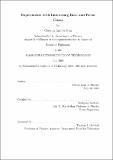| dc.description.abstract | In the past few years, the study of trapped fermionic atoms evolved from the first
cooling experiments which produced quantum degenerate samples to becoming one
of the most exciting branches of current atomic physics research. This thesis covers
experiments done throughout this period, which can be grouped in three sets of studies.
First, degenerate 6Li Fermi gases have been produced by sympathetic cooling
with bosonic 23Na. For this, an existing 23Na Bose-Einstein condensation apparatus
was upgraded to an experiment capable of producing degenerate 6Li Fermi gases and
6Li-23Na degenerate Fermi-Bose mixtures.
The cooling methods have been developed in two different stages, resulting in the
production of degenerate 6Li Fermi gases with temperatures below 0.05 TF and up to
7 × 10⁷ atoms, and of degenerate 6Li-23Na mixtures with a few million atoms in each
of the components.
Second, the properties of 6Li-23Na mixtures at different magnetic fields have been
investigated, resulting in the discovery of three interspecies 6Li-23Na Feshbach resonances, which opens up the possibility to study strongly interacting Bose-Fermi mixtures in this system. This investigations also led to the observation of other Feshbach resonances in 6Li and 23Na.
Third, the properties of strongly interacting 6Li spin mixtures in the strong interacting regime near a Feshbach resonance have been investigated. Weakly bound
6Li2 molecules have been produced and Bose condensed on the repulsive side of the
Feshbach resonance. Pure molecular condensates with up to 3 × 10⁶ molecules have
been produced.
The properties of the interacting Fermi gas were investigated on the attractive side
of the resonance using rapid field ramps to the other side of the resonance. Fermion
pairing, and condensation of these pairs was observed near the resonance, offering
evidence for superfluid behavior in a strongly interacting Fermi gas. | en |
